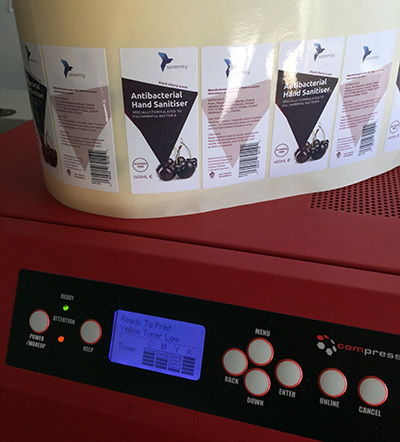The latest investment at Talbot Chemicals is a Compress LP4 LED label printer from Impression Technology Europe
Based in Newark, in Nottinghamshire, Talbot Chemicals first decided to take label printing in house 10 years ago. Neel Madsen went to speak to production manager Stephen Greenwood about how the company now utilises digital to serve its labelling needs.
Housed in a purpose-built factory on the Brunel Drive industrial estate, Talbot Chemicals produces a wide variety of chemical cleaning products for catering cleaning suppliers, general cleaning companies, wholesalers, cash and carry, as well as automotive cleaning companies. The manufacturer originally bought-in labels from trade, then progresses to a ribbon and film transfer system, before making the move in 2011 to a digital printer and a label finishing machine from Impression Technology Europe (ITE). Last year, Talbot added a Compress LP4 digital label printer to its inventory.
Mr Greenwood said, ‘Requirements vary and often we’ll get asked to produce 20 bottles of one kind, or full pallets of 20 of one kind of label and 20 another kind. We realised this was inefficient in terms of ordering minimum quantities of labels, and having to store these, not to mention waiting for delivery and having to pass that extra time on to the customer. At base level it was also proving expensive, and so we began to think outside of the box, and purchased a four-colour ribbon printer 10 years ago. This was step 1 for us and gave us the confidence to take more control in house.’ He continued, ‘However, the ribbons were expensive, and we were very limited in the type and size of labels we could produce. Having to cut labels to size by hand was just not cost effective, and only being able to print solids was a real issue.’
Customers were increasingly asking for much shorter runs and different size labels with more challenging designs, while a gradual change in legislation was resulting in residual stock, so the need to move to digital became obvious.
Mr Greenwood continued, ‘After speaking with ITE we realised we could optimise even further. They recommended the Rapid X1 printer, which we used for four years. To add an extra layer, they also suggested we actually cut our own labels to size, meaning we’d just order in one roll of material and then be able to cut every single label on one unit. The unit just bolts on to the digital printer. So we invested in an Eclipse LF3 label finishing machine. It was a fairly bold move and significant investment, but one we definitely do not regret.’
Talbot Chemicals has its own blow-moulding facilities and manufactures containers to customers’ specifications, with labels designed (as needed) and printed in house. The products most often need batch numbers, use by dates and one or more CLP hazard pictograms. Mr Greenwood said, ‘Our customers are not trying to compete with the big brands, but they still want their products to look great and we can offer that. The labels also have to comply with legislation. There is a lot of information to fit in, but with our new system, we can react to changes straightaway, whereas before would have needed to re-order and potentially dispose of redundant label stock.’
The latest investment is a Compress LP4 LED dry toner label printer, which run at speeds up to 9.14 m/min printing at a maximum print resolution of 600 x 1200 dpi. Mr Greenwood said, ‘As technology progressed we moved on to a Compress LP4, which has reduced the cost of ink dramatically, half the price, in fact. Cost wise we’ve shaved 40% off each label produced. The glory is that the labels it produces are virtually waterproof, so we can save on over-laminating too. Maintenance is easy and the printer is ready to print within a few minutes when I switch it on each morning.’
Talbot Chemicals is the perfect example of how digital label printing can easily be part of the in-house production no matter the size or type company. It offers the manufacturer agility with quick turnaround, just in time production and no limit on design changes or number of labels produced.
Mr Greenwood concluded, ‘I think some companies might not be quite sure about how easy it is to manage your own printer and cutter. We have no issues whatsoever using the machines. I can’t fault the Eclipse LF3, it’s evolved since it was launched and ITE don’t stand still – they continue to innovate. We use an artwork package for the label design, and the labels print beautifully on the Compress LP4.’






